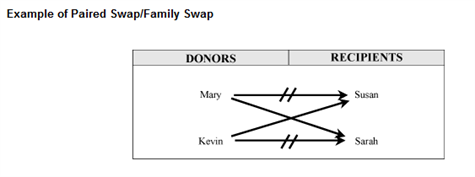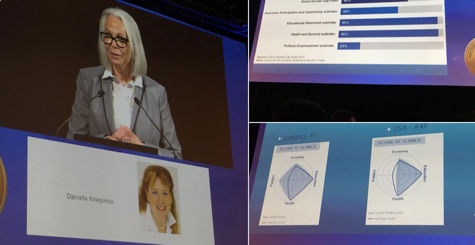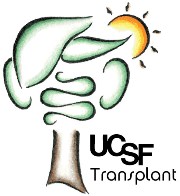Living Donor Kidney Transplant
As kidneys become diseased, they lose their ability to function, a condition called end-stage renal disease (ESRD) or kidney failure. Treatments for kidney failure are hemodialysis, a mechanical process to clean the blood of waste products; peritoneal dialysis, in which toxins are removed by passing chemical solutions through the abdomen; or kidney transplant.
In 2017, UCSF's Kidney Transplant Program earned the highest score for risk adjusted outcomes based on data from the Scientific Registry of Transplant Recipients (SRTR) using SRTR's new "5-Tier Outcome Assessment" model. Among those institutions receiving the highest ranking nationally, UCSF ranked first in the number of adult kidney transplants performed.
Living Donors
LIVING DONOR - KIDNEY TRANSPLANT from stewart cheifet on Vimeo.
Kidneys for transplant come from a living donor or a deceased (cadaver) donor. When a kidney is transplanted from a living donor, the donor's remaining kidney enlarges to take over the work of two. As with any major operation, there is a chance of complication. But kidney donors have the same life expectancy, general health and kidney function as others.
Any healthy person can safely donate a kidney. The donor must be in excellent health, well informed about transplantation and able to give informed consent. Costs for living donor surgery, hospitalization, diagnostic tests and evaluation usually are paid by the recipient's insurance. Travel and living expenses are not covered. Insurance coverage will be discussed during the transplant evaluation.
If you have a potential living donor, he or she will undergo an evaluation and discuss the possibility of organ donation. Tests will be performed to ensure that the donor and recipient are compatible. In some families, several people are compatible donors. In other families, none are suitable.
Since 1999, UCSF has been using a procedure, called laparoscopic donor nephrectomy, to remove kidneys from living donors. We have performed more than 850 of these procedures, making our program one of the most experienced in the country. The procedure uses tiny incisions and a scope or camera, similar to one used to remove a gall bladder. The procedure has a shorter recovery period and the complication rate is very low. In addition, the quality and function of the transplanted kidneys are excellent.
The procedure will be described in detail by the surgeon prior to surgery. The operation usually takes three hours. Most patients undergoing laparoscopic surgery for kidney donation require a hospital stay of only two to three days. After discharge from the hospital, the donor is seen for follow-up care in the transplant clinic. If the donor resides outside the San Francisco region, he or she should stay in the area for at least a week after discharge. Donors who undergo laparoscopic surgery often return to work within three to four weeks after the procedure.
Living Donor Kidney Transplantation
Living donor kidney transplants are the best option for many patients for several reasons:
- Better long-term results
- No need to wait on the transplant waiting list for a kidney from a deceased donor
- Surgery can be planned at a time convenient for both the donor and recipient
- Lower risks of complications or rejection, and better early function of the transplanted kidney
Any healthy person can donate a kidney. When a living person donates a kidney the remaining kidney will enlarge slightly as it takes over the work of two kidneys. Donors do not need medication or special diets once they recover from surgery. As with any major operation, there is a chance of complications, but kidney donors have the same life expectancy, general health, and kidney function as most other people. The kidney loss does not interfere with a woman's ability to have children.
Potential Barriers to Living Donation
- Age < 18 years unless an emancipated minor
- Uncontrollable hypertension
- History of pulmonary embolism or recurrent thrombosis
- Bleeding disorders
- Uncontrollable psychiatric illness
- Morbid obesity
- Uncontrollable cardiovascular disease
- Conronic lung disease with impairment of oxygenation or ventilation
- History of melanoma
- History of metastatic cancer
- Bilateral or recurrent nephrolithiasis (kidney stones)
- Chronic Kidney Disease (CKD) stage 3 or less
- Proteinuria > 300 mg/d excluding postural proteinuria
- HIV infection
If a person successfully completes a full medical, surgical, and psychosocial evaluation they will undergo the removal of one kidney. Most transplant centers in the United States use a laparoscopic surgical technique for the kidney removal. This form of surgery, performed under general anesthesia, uses very small incisions, a thin scope with a camera to view inside of the body, and wand-like instruments to remove the kidney. Compared with the large incision operation used in the past, laparoscopic surgery has greatly improved the donor's recovery process in several ways:
- Decreased need for strong pain medications
- Shorter recovery time in the hospital
- Quicker return to normal activities
- Very low complication rate
The operation takes 2-3 hours. Recovery time in the hospital is typically 1-3 days. Donors often are able to return to work as soon as 2-3 weeks after the procedure.
Occasionally the kidney needs to be removed through an open incision in the flank region. Prior to the use of the laparoscopic technique, this surgery was the standard for the removal of the donated kidney. It involves a 5-7 inch incision on the side, division of muscle and removal of the tip of the twelfth rib. The operation typically lasts 3 hours and the recovery in the hospital averages 4-5 days with time out of work of 6-8 weeks.
Although laparoscopy is increasingly used over open surgery, from time to time, the surgeon may elect to do an open procedure when individual anatomic differences in the donor suggest that this will be a better surgical approach.
The quality and function of the kidneys recovered with either technique work equally well. Regardless of technique all donors will require lifelong monitoring of their overall health, blood pressure and kidney function.
Special Programs For Living Donor Transplantation
Many patients have relatives or non-relatives who wish to donate a kidney but are not able to because their blood type or tissue type does not match. In such cases, the donor and recipient are said to be "incompatible."
See also: National Kidney Registry
Live Donor to Deceased Donor Waiting List Exchange
This program is a way for a living donor to benefit a loved one, even if their blood or tissue types do not match. The donor gives a kidney to another patient who has a compatible blood type and is at the top of the kidney waiting list for a "deceased donor" kidney. In exchange, that donor's relative or friend would move to a higher position on the deceased donor waiting list, a position equal to that of the patient who received the donor's kidney.
For example, if the donor's kidney went to the fourth patient on the deceased donor waiting list, the recipient would move to the fourth spot on the list for his or her blood group and would receive kidney offers once at the top of the list.
Paired Exchange Kidney Transplant (or "Family Swap")
This program is another way for a living donor to benefit a loved one even if their blood or tissue types do not match. A "paired exchange" allows patients who have willing but incompatible donors to "exchange" kidneys with one another-the kidneys just go to different recipients than usually expected.
An example of how this works would be if Mary wanted to give her sister Susan a kidney, but differences in blood type made it impossible, and Kevin wanted to give his sister Sarah a kidney, but differences in blood type made that impossible (see picture below). A paired exchange would be arranged so that Mary would donate to Sarah and Kevin would donate to Susan. The two pairs can thus "exchange" kidneys so that both donors give kidneys and both patients receive kidneys.
That means that two kidney transplants and two donor surgeries will take place on the same day at the same time.

Blood Type Incompatible Kidney Transplant
This is a program that lets patients receive a kidney from a living donor who has an incompatible blood type. To be able to receive such a kidney, patients must undergo several treatments before and after the transplant to remove the harmful antibodies that can lead to rejection of the transplanted kidney.
A special process called plasmapheresis, which is similar to dialysis, is used to remove these harmful antibodies from the patient's blood.
Patients require multiple treatments with plasmapheresis before transplant, and may require several more after transplant to keep their antibody levels down. Some patients may also need to have their spleens removed at the time of transplant surgery to lower the number of cells that produce antibodies. The spleen, a spongy organ about as big as a person's fist, produces blood cells. Located in the upper left part of the abdomen under the rib cage, the spleen can be removed laparoscopically.
Positive Crossmatch and Sensitized Patient Kidney Transplant
This program makes it possible to perform kidney transplants in patients who have developed antibodies against their kidney donors-a situation known as "positive crossmatch."
The process is similar to that for blood type-incompatible kidney transplants. Patients receive medications to decrease their antibody level or they may undergo plasmapheresis treatments to remove the harmful antibodies from their blood. If their antibody levels to their donors are successfully reduced, they can then go ahead with the transplants.
Blood type-incompatible kidney transplants and positive crossmatch/sensitized patient kidney transplants have been very successful in the United States and internationally. Success rates are close to those for transplants from compatible living donors and are better than success rates for deceased donor transplants.
Videos and Patient Stories
Living Donor Kidney Video (English)
Living Donor Kidney Video (Spanish)
We are Transplant: Stories from the Novartis Transplant Games (Videos of the Gift of Living Donation)

















